You’ll find Tucson a city of wide skies, saguaros and layered history where Spanish missions sit beside modern art and Sonoran flavors shape every meal. Plan mornings for hikes in Saguaro National Park, afternoons for museums and mercados, and cool evenings for patios or stargazing. This guide covers best seasons, top sights, practical tips and sample itineraries so you can make the most of each day — and know exactly what to pack before you set out.
Why Visit Tucson: What Makes the City Special
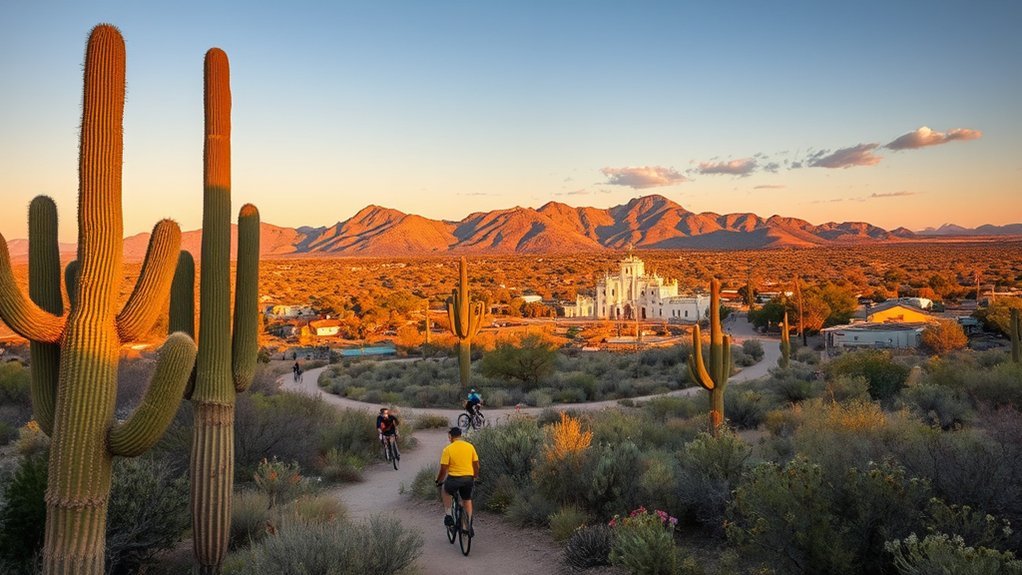
Come for the wide-open desert skies and stay for a blend of cultures, flavors, and landscapes you won’t find anywhere else. You’ll notice Spanish colonial missions, Pueblo and O’odham influences, and modern Southwestern design woven into neighborhoods and markets. You’ll wander cactus-studded trails beneath saguaro silhouettes, then shift to urban murals, independent galleries, and a lively music scene. You’ll taste distinctive Sonoran cuisine — from smoky mesquite to prickly pear accents — and find world-class Mexican bakeries, contemporary bistros, and farm-to-table eateries. You’ll explore scientific and cultural institutions like the Arizona-Sonora Desert Museum and Kitt Peak, where accessibility and interpretation make learning vivid. You’ll appreciate outdoor diversity: desert basins, sky islands, and riparian corridors host surprising biodiversity and photographic opportunities. You’ll find friendly, approachable locals who value heritage and innovation. In Tucson, contrasts — old and new, arid and lush, solitude and community — don’t clash; they complement one another, giving you a compact city full of layered discovery.
Best Time to Go and Weather Considerations
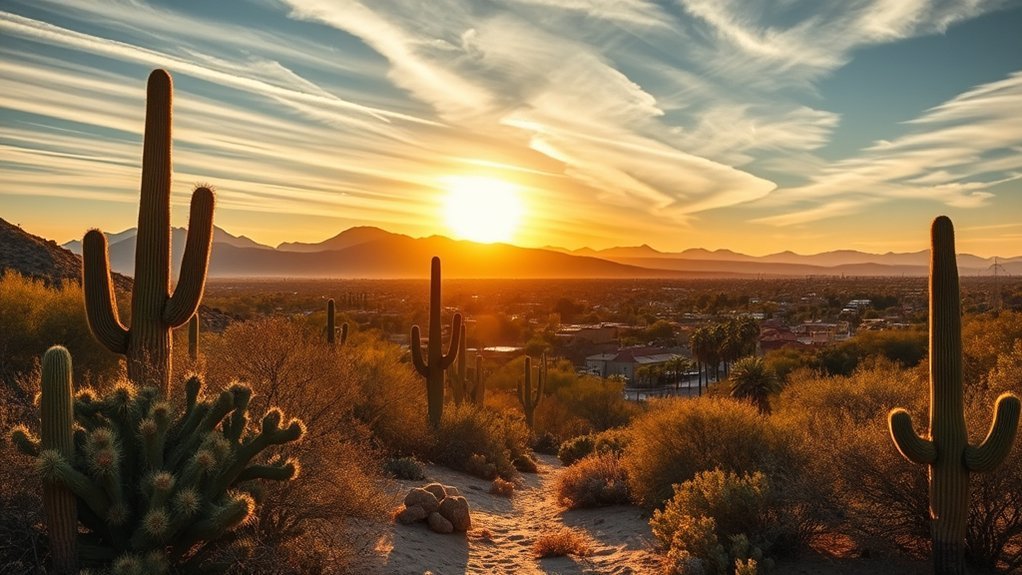
Although summers can be intense, the best times to visit Tucson are spring and fall, when daytime temperatures sit comfortably in the 70s–80s°F (20s–30s°C) and desert blooms or autumn light make the landscape especially beautiful. You’ll find mornings cool and clear, ideal for hiking saguaro-studded trails before the sun climbs. Spring brings vibrant wildflowers after winter rains; plan for occasional windy days and pack a light jacket for breezy evenings. Fall offers softer sun and longer golden hours, perfect for photography and outdoor dining. Summers are hot — often exceeding 100°F (38°C) — so if you travel then, schedule activities early, hydrate constantly, and seek shade midday. Monsoon season (July–September) delivers dramatic storms and brief heavy rain; they cool the air but can cause flash floods on desert roads. Winters are mild with chilly nights; bring layers for desert temperature swings. Check forecasts, adjust plans for heat or storms, and you’ll make the most of Tucson’s unique climate.
Top Attractions and Must-See Sights
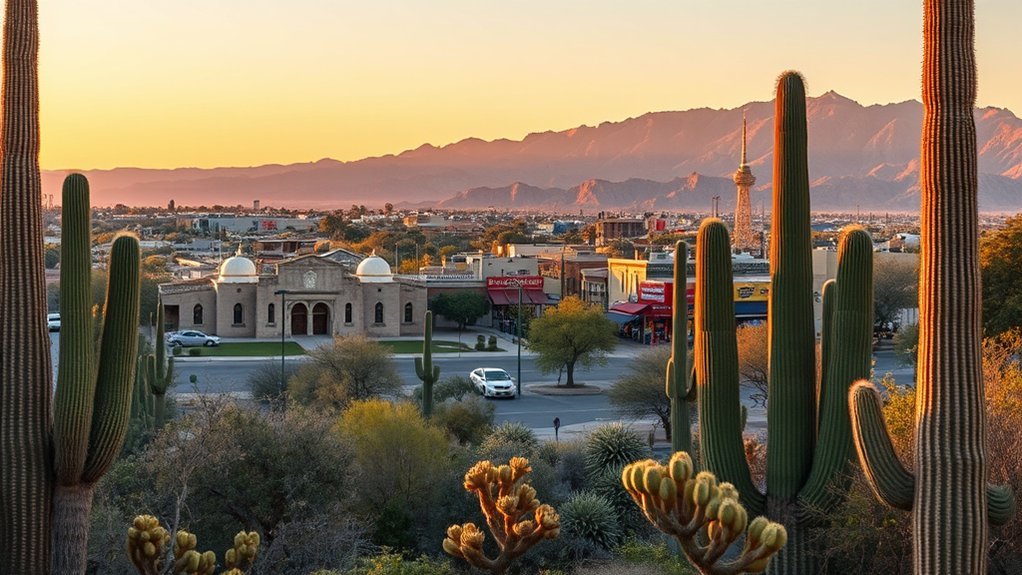
With the best seasons and weather in mind, you can plan which Tucson sights will shine for you—whether that’s sunlit saguaros at sunrise or storm-lit skies over the mountains. You’ll find history, art, and desert character woven into compact, memorable spots. Wander mission-era stonework, explore vibrant barrios, and let architectural details tell stories.
- Mission San Xavier del Bac — white stucco, ornate interior, quiet courtyard that frames desert light.
- Arizona-Sonora Desert Museum — living exhibits where cacti silhouettes and birdcalls set a desert theater.
- Pima Air & Space Museum — rows of classic aircraft under vast blue skies, each fuselage a travelogue.
- Tucson Museum of Art & Historic Block — galleries, adobe facades, and sculpture gardens that connect past and present.
Plan visits so you experience interiors in cooler hours and plazas when shadows fall. These attractions show Tucson’s cultural layers without sending you deep into wilderness logistics.
Outdoor Activities and Hiking Essentials
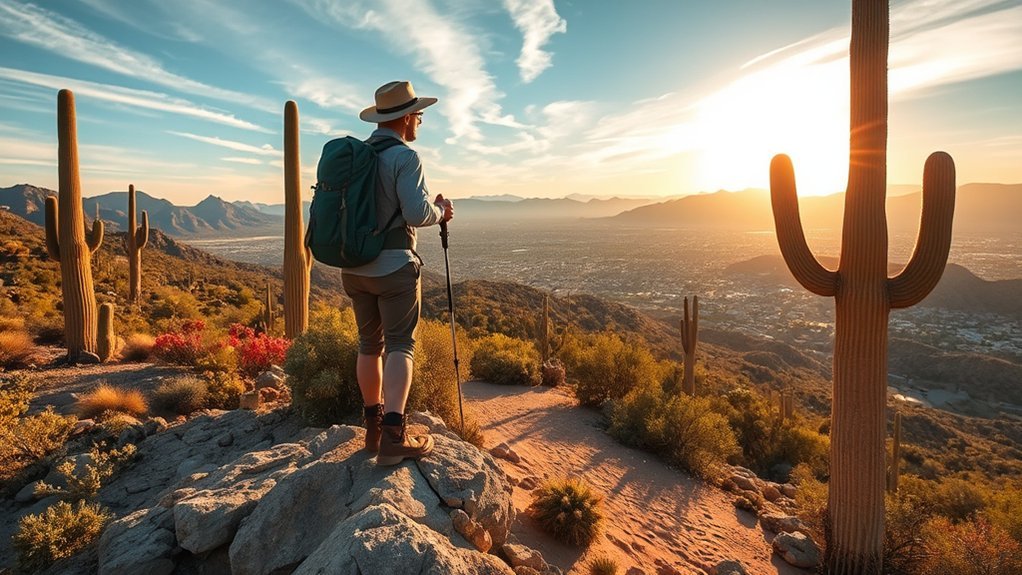
Often you’ll find Tucson’s outdoor life unfolding at first light or in the cool hour before sunset, when trails, washes, and peaks reveal cactus silhouettes, birdcalls, and the desert’s shifting light. You’ll want sun protection—hat, sunglasses, high-SPF sunscreen—and layered clothing for temperature swings. Carry at least two liters of water per person on longer hikes and use a hydration pack for hands-free sipping. Pick trails that match your fitness: easy loop walks in Saguaro National Park, moderate ridgeline treks at Tumamoc Hill, or challenging ascents on Mount Lemmon. Use a trail map or app, note mileage and elevation gain, and tell someone your route. Watch for wildlife—javelina, rattlesnakes, and migratory birds—and keep a respectful distance. Leave no trace: pack out trash and avoid trampling fragile desert flora. If you hike after monsoon storms, expect quick wash flows and cooler mornings. With preparation and awareness, you’ll enjoy Tucson’s vivid, ever-changing landscapes safely.
Where to Eat: Sonoran Cuisine and Local Favorites
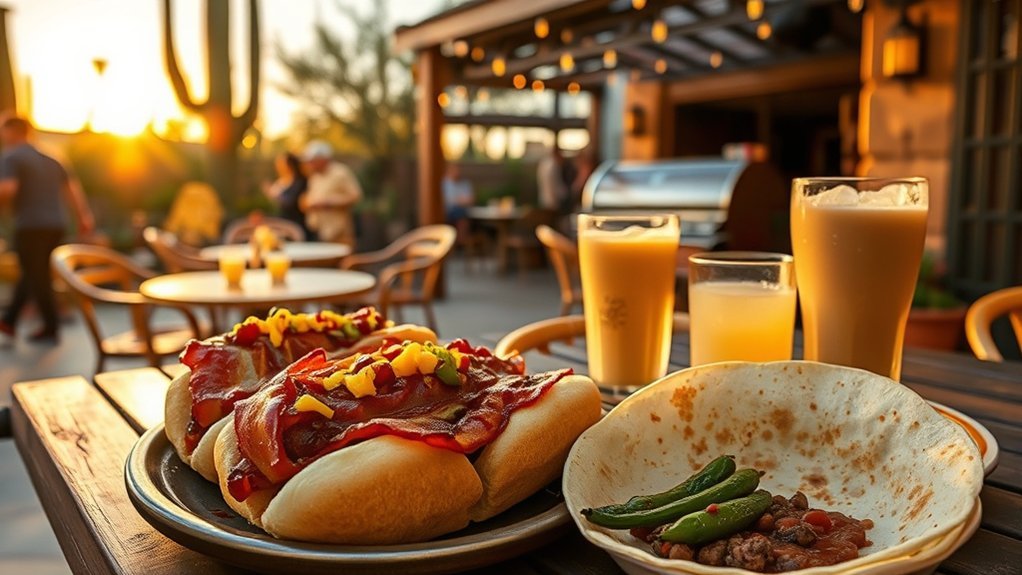
You’ll find Tucson’s street food gems—tiny carts and hole-in-the-wall taquerias—serving hot, hand-rolled tortillas and brisk, citrus-bright salsas. Try Sonoran staples like carne asada, chimichangas, and the region’s signature Sonoran hot dog to taste the city’s heritage. Don’t miss markets and farmers’ stalls where fresh nopales, chilies, and local cheeses let you build your own authentic meal.
Street Food Gems
Frequently, the best way to taste Tucson is to follow the smells — grilled mesquite, chile-laced salsas, and warm flour tortillas — to small carts, hole-in-the-wall stands, and bustling markets where Sonoran flavors shine. You’ll find vendors who move fast, voices calling specials, and steam rising from comales. Watch tortillas blister, trompos rotate, and sauces get ladled with expert hands. Don’t miss late-night taco carts after a show, or mercados where fruit cups glisten with lime and chile. Picture these scenes:
- A busy corner cart, smoke curling, tortillas puffing.
- A tiled mercado stall, colorful salsas lined like jewels.
- A family-run trailer, secrets folded into each burrito.
- A twilight queue, hungry locals swapping recommendations.
Trust your nose and ask for the house favorite.
Sonoran Staples
After following those smoky streets to your favorite taco cart, you’ll want to sit down to the dishes that define Tucson: Sonoran staples built on fresh corn and flour tortillas, mesquite-charred meats, and bright, chile-forward salsas. You’ll taste carne asada seared over mesquite, rellenos stuffed with local cheeses, and flour tortillas wrapped around hearty Sonoran hot dogs. Look for layered flavors—lime, oregano, roasted chiles—and simple preparations that spotlight ingredient quality. Ask for salsa cruda and a side of pickled onions. Portions are generous; share plates let you sample widely. Below is a quick guide to help you choose:
| Dish | Why it matters |
|---|---|
| Carne Asada | Charred aroma, tender beef |
| Sonoran Hot Dog | Local twist, savory-sweet toppings |
| Chile Relleno | Fresh chiles, melty cheese |
| Nopales Salad | Cactus texture, vegetal brightness |
| Menudo | Hearty, traditional comfort |
Markets & Farmers
Often mornings are the best time to wander Tucson’s markets and farmers’ stands, where local growers, cheese makers, and tortilla artisans lay out the season’s freshest produce, heirloom corn, and roasted chiles. You’ll inhale warm masa, tangy citrus, and the smoke of chiles over wood. Stallholders tell stories about irrigation, native seeds, and small-batch cheeses while you sample prickly pear jam and fresh queso. Move slowly, ask questions, and buy something to support local traditions. Picture:
- A crate of multicolored heirloom tomatoes glistening with dew.
- A stack of hand-pressed tortillas steaming in a cloth.
- Baskets of roasted green chiles, skins blistered and smoky.
- A vendor slicing crumbly goat cheese beside jars of bright salsa.
These markets teach you how Sonoran flavors are born.
Arts, Museums, and Cultural Experiences
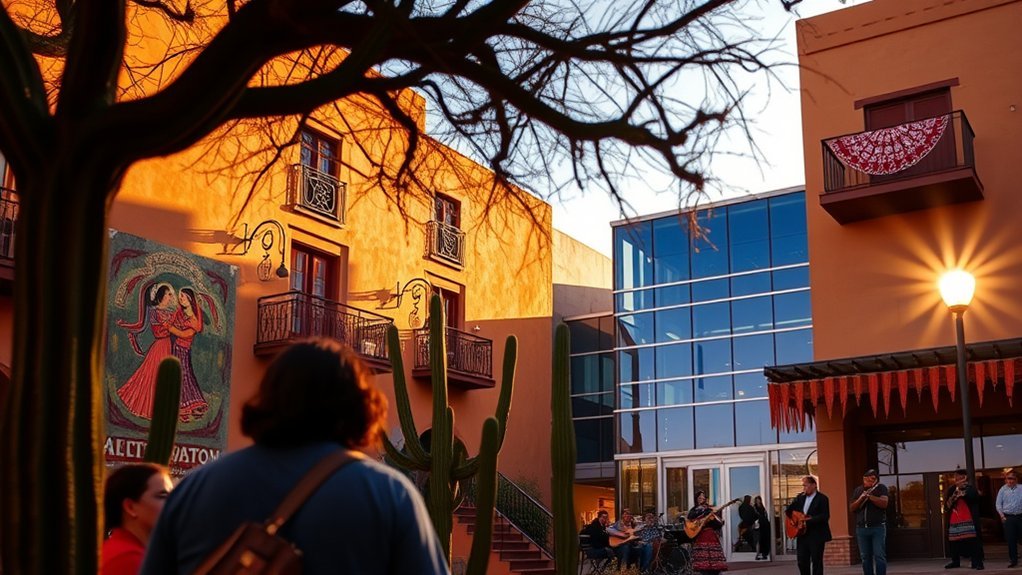
When you step into Tucson’s arts scene, you’ll find a lively mix of Indigenous heritage, contemporary galleries, and hands-on museums that reflect the city’s desert spirit. You can start at the Tucson Museum of Art to see regional painters and mission-era pieces, then move to the Center for Creative Photography for striking archives and rotating exhibits. Visit the Heard Museum North or local Pueblo events to connect with Tohono O’odham and other Indigenous traditions—ceramics, textiles, and stories are presented with care. Downtown’s 4th Avenue and the Warehouse Arts District host intimate galleries, street murals, and artist studios where you’ll meet creators working in glass, metal, and print. For interactive learning, the Arizona-Sonora Desert Museum blends natural history with artful displays of desert life. Check gallery hours and exhibit schedules before you go, and look for First Thursday art walks and cultural festivals—those offer concentrated access to openings, performances, and conversations with artists that deepen your understanding of Tucson’s creative pulse.
Sample Itineraries: 24 Hours to a Week
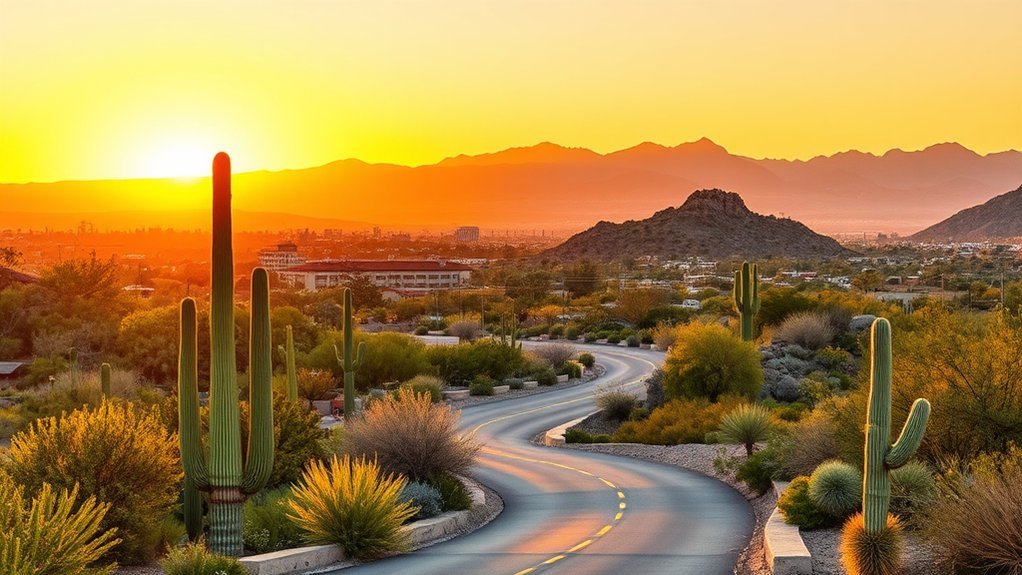
If you’ve only got 24 hours, you can loop through downtown’s historic sites, Sonoran cuisine spots, and evening music scene with an easy walking route. Spend three days tracing the desert’s highlights — Saguaro National Park, Tucson Mountain Park, and Mission San Xavier del Bac — for a balanced mix of hikes and cultural stops. With a full week you can take an immersive route that adds neighborhood exploration, museum hours, scenic drives, and time to relax under wide desert skies.
24‑Hour Downtown Loop
Though a single hour won’t cover everything downtown, you can still get a vivid taste of Tucson’s heart by focusing on a tight loop: stroll past the Mission Revival courthouse, duck into a gallery or two in the Arts District, grab a strong coffee or Sonoran hot dog, and pause at Presidio Park to soak up city history and mountain views—each stop sits close enough that you won’t waste time in transit, letting you sample the city’s flavors and character even on a short schedule. Move deliberately: cobbled sidewalks, colorful murals, and popup vendors tell stories. Aim for this quick sequence to maximize impressions:
- Sunlit courthouse façade and plaza.
- Intimate gallery with local prints.
- Corner café or hot dog cart aroma.
- Presidio Park overlook with saguaro-framed peaks.
3‑Day Desert Highlights
You’ve tasted downtown’s pulse; now head for the desert to see the landscape that shapes Tucson’s skyline. Spend a day moving between saguaros, washes and red-rock ridges: sunrise at Saguaro National Park’s East unit, a midmorning hike on a shaded trail, and a sunset photo stop at Gates Pass. You’ll spot ocotillo flickering like brushes, hear distant coyotes, and feel the sun soften into golden hours.
| Dawn | Midday | Dusk |
|---|---|---|
| Saguaro silhouettes | Shaded trail walking | Gates Pass view |
| Cool light, quiet | Birdsong, heat shifts | Long shadows, color |
| Sparse flora close-ups | Picnic or field guide | Crisp evening air |
Plan water, sun protection, and pacing so you enjoy the desert’s sculpted calm.
7‑Day Immersive Route
Map out your day to move smoothly from sunrise saguaro rings to starlit desert silence, choosing an itinerary that fits whether you’ve got 24 hours or seven days. You’ll layer immersive experiences so each hour builds: morning hikes through prickly silhouettes, midday museum or market stops, late-afternoon desert drives, and evening dining under wide skies. Pick a pace—fast for a day, unrushed for a week—and let shifts feel intentional.
- Sunrise hike: cool air, long shadows, songbirds.
- Midday culture: Sonoran cuisine, Tucson Museum, shaded plazas.
- Afternoon drive: winding roads, cactus vistas, roadside viewpoints.
- Evening calm: rooftop cocktails, telescope nights, endless stars.
Adjust distances and rest; this route keeps you present and curious.
Getting Around: Transportation and Parking Tips
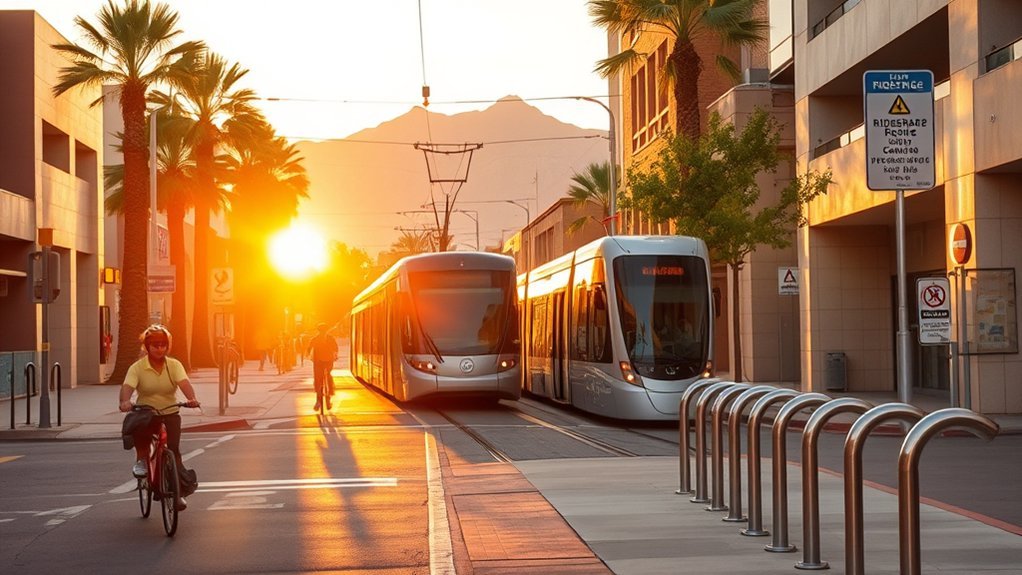
When you’re exploring Tucson, getting around is straightforward whether you’re driving, biking, or using public transit; each option has its own quirks to keep in mind. You’ll find wide roads and ample parking near malls and many attractions, but downtown and popular trailheads can fill up fast—look for metered spots, pay-by-app zones, and short-term lots. The Sun Tran bus system covers the city affordably; routes and real-time arrivals are on their app, so plan transfers during peak heat. Sun Link streetcar serves the central corridor and University area, handy for museum and restaurant hops. Tucson’s bike network is extensive with dedicated lanes and shared paths like the Loop—rent a bike for neighborhood cruising, but carry water and a helmet. If you rent a car, choose a compact size for narrow historic streets and check lot restrictions at state parks. Rideshares are widely available; estimate fares for late-night returns. Keep maps or offline directions ready in case cell service lags.
Practical Travel Tips and Safety in the Desert
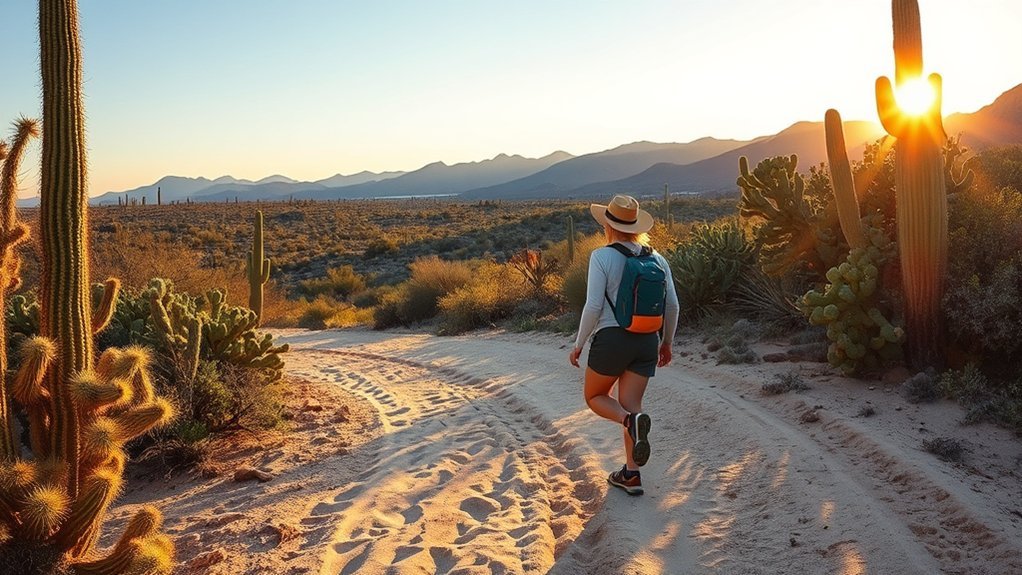
Because desert conditions change fast, plan your days around heat, sun, and limited shade so you won’t get caught off guard. Stay hydrated—carry extra water, sip often, and avoid alcohol midday. Wear a wide-brim hat, UV-blocking sunglasses, and breathable long sleeves to protect skin while keeping cool. Start hikes early, know trail lengths, and tell someone your route and return time.
- Visualize the sun’s arc: shade vanishes by midafternoon, so pick morning or late afternoon outings.
- Picture your pack: water, electrolyte tablets, sunblock, map, whistle, and basic first-aid.
- Imagine the terrain: rocky washes and cacti mean sturdy shoes and careful footing.
- Sense the temperature drop: nights can be chilly—layer up for sudden shifts.
Be alert for wildlife, avoid touching plants, and watch weather forecasts for flash-flood warnings. If you get lost, stay put, signal with bright clothing, and conserve water while emergencies are resolved.
Frequently Asked Questions
Are There Guided Night Sky or Astronomy Tours in Nearby Dark-Sky Areas?
Yes — you can join guided night-sky and astronomy tours in nearby dark-sky areas. You’ll learn constellations, use telescopes, hear expert commentary, and photograph the Milky Way while enjoying minimal light pollution and clear desert skies.
Can I Bring My Pet to Popular Hiking Trails and Outdoor Attractions?
Usually you can bring pets on many trails, but rules vary by park and trailhead; you’ll need leashes, waste bags, and water. Check specific trail regulations, seasonal closures, and sensitive wildlife areas before heading out.
What Vaccinations or Health Precautions Are Recommended Before Visiting Tucson?
You should make sure routine vaccinations are up to date (MMR, Tdap, flu), consider COVID boosters if eligible, and protect against insect-borne diseases with repellents, sunscreen, hydration, and heat illness precautions during hot, dry Tucson conditions.
Are There Accessible (Wheelchair-Friendly) Routes at Major Outdoor Sites?
Yes — many major outdoor sites offer wheelchair-friendly routes and facilities. You’ll find paved trails, accessible visitor centers, designated parking, and assisted viewpoints at places like Saguaro and Sabino Canyon, though some rugged areas remain challenging.
Where Can I Find Local Farmers’ Markets and Craft Fairs Schedules?
Like a calendar blooming, you’ll find schedules on Visit Tucson’s events page, the Tucson Farmers’ Market Coalition site, local library/community center boards, and social pages for Mercado San Agustín, St. Philips, and Barrio Brewing pop-up markets.
Conclusion
You’ll leave Tucson convinced the desert’s quiet holds surprising life—verify the theory that arid landscapes sharpen the senses: wake to cactus silhouettes, taste prickly pear sweetness, and watch stars reclaim the sky. Mornings suit hikes and markets, afternoons museums and shaded plazas, evenings rooftop meals or stargazing. Pack sun protection, water, and layers, use Sun Tran or rent a car for day trips, and visit spring or fall for the very best weather.

